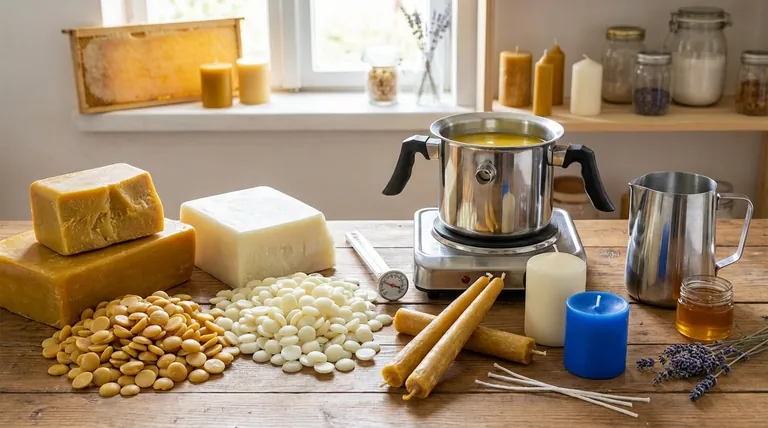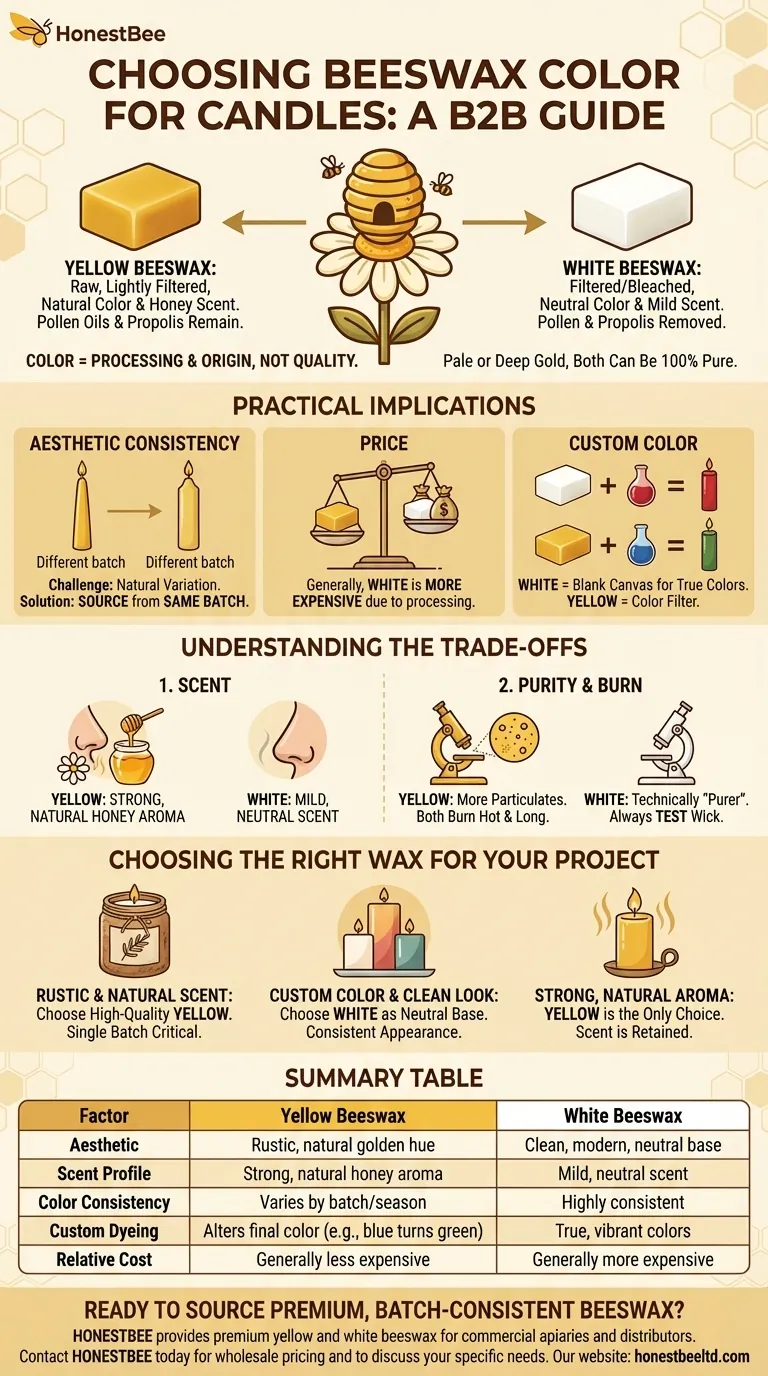When choosing beeswax for candles, the primary factors to consider are your aesthetic goal, budget, and the need for color consistency, not the inherent quality of the wax. The natural color, which ranges from pale white to deep gold, is determined by the pollen and nectar the bees collected and the level of filtration the wax has undergone.
The color of beeswax is a matter of processing and origin, not a measure of quality. Your choice between yellow and white wax will fundamentally impact your candle's final appearance, scent profile, and your ability to add custom color.

Deconstructing Beeswax Color
To make an informed choice, you must first understand what the color signifies. The shade of your beeswax is a direct result of its journey from the beehive to your workshop.
The Source of Natural Color
The beautiful yellow and golden hues of natural beeswax come from pollen oils and propolis that mix with the wax in the hive. The specific floral sources the bees forage from will create different shades, meaning even "natural" yellow wax can vary dramatically from one region or season to another.
Yellow vs. White Beeswax
Yellow beeswax is the raw, largely unprocessed state. It is typically only lightly melted and filtered to remove hive debris, which preserves its natural color and distinct, sweet honey scent.
White beeswax starts as yellow beeswax. It is then filtered—often multiple times through methods like carbon filtering—or naturally sun-bleached to remove the pollen and propolis, resulting in a neutral color and a much milder scent.
Why Color Doesn't Signal Quality
A common misconception is that a darker, richer yellow indicates a higher quality wax. In reality, both a pale white and a deep golden wax can be of excellent, 100% pure quality. The color simply tells you about its origin and how much it has been processed.
The Practical Implications of Your Choice
Your decision between yellow and white wax has direct consequences for your candle-making process and the final product.
Achieving Aesthetic Consistency
The most significant challenge with beeswax is its natural color variation. If you are making a set of candles, such as a pair of tapers, you must source all your wax from the exact same batch. Wax from a different supplier, or even a different harvest from the same apiary, can have a noticeably different shade.
The Impact on Price
Generally, white beeswax is more expensive than yellow beeswax. This price difference is due to the additional labor and processing required to filter and decolorize the wax. However, highly desirable golden yellow waxes from specific floral sources can also command a premium.
Adding Custom Color
If you plan to dye your candles, your base wax color is critical.
- White beeswax provides a neutral, blank canvas, allowing for true and vibrant colors.
- Yellow beeswax will act as a color filter. Adding blue dye will result in a green candle, and red dye will create an orange one.
Understanding the Trade-offs
Choosing a color is not just about visuals; it involves balancing scent, burn characteristics, and purity.
Scent: Natural vs. Neutral
The most significant trade-off is scent. The filtration that creates white beeswax also strips away much of its characteristic honey-like aroma. If that natural, sweet scent is a key feature you want, you must use yellow beeswax.
Purity and Burn Properties
While both types are excellent, yellow beeswax contains more microscopic particulates like pollen. Heavily filtered white wax is therefore technically "purer" in composition. This can lead to very subtle differences in burn, though both burn hotter and longer than soy or paraffin. Always test your wick size with your specific batch of wax to ensure a clean, proper burn.
Choosing the Right Wax for Your Project
Your goal should dictate your choice. Use these guidelines to make a clear decision.
- If your primary focus is a rustic aesthetic and natural honey scent: Choose a high-quality yellow beeswax and be sure to purchase enough from a single batch for your entire project.
- If your primary focus is creating custom-colored candles or a clean, modern look: Choose white beeswax to serve as a neutral base for dyes and provide a consistent appearance.
- If your primary focus is a strong, natural aroma: Yellow beeswax is the only choice, as its scent is a direct result of the compounds removed during the whitening process.
Ultimately, understanding what beeswax color truly represents empowers you to select the perfect material for your specific creative vision.
Summary Table:
| Factor | Yellow Beeswax | White Beeswax |
|---|---|---|
| Aesthetic | Rustic, natural golden hue | Clean, modern, neutral base |
| Scent Profile | Strong, natural honey aroma | Mild, neutral scent |
| Color Consistency | Varies by batch/season | Highly consistent |
| Custom Dyeing | Alters final color (e.g., blue turns green) | True, vibrant colors |
| Relative Cost | Generally less expensive | Generally more expensive |
Ready to source the perfect beeswax for your candle-making business?
As a leading wholesale supplier to commercial apiaries and beekeeping equipment distributors, HONESTBEE provides premium, batch-consistent yellow and white beeswax to ensure your products meet the highest standards of quality and aesthetic appeal. Let us help you achieve your creative vision with reliable materials.
Contact HONESTBEE today for wholesale pricing and to discuss your specific needs.
Visual Guide

Related Products
- Beeswax Melter for Candle Making Honey Bee Wax Melter
- Steam Beeswax Melter Wax Warmer for Wax Processing
- Electric Beeswax Foundation Machine With Operating Tray and Wax Foundation Roller
- Honey Wax Separating Wax Press with Metal Screw Wax Separator Machine
- Professional 500g Sectional Comb Honey Frame System for Beekeeping
People Also Ask
- What is the flashpoint of beeswax? Essential Safety and Quality Tips for Beekeepers
- What are the main types of wax melters? Choose the Right Heating Method for Your Needs
- What is the recommended temperature range for melting beeswax? Achieve Perfect Quality & Safety
- What is the best way to melt beeswax for candles? The Safest Method for Professional Results
- How do water jacket melters function? Achieve Gentle, Scorch-Free Melting for Sensitive Materials













